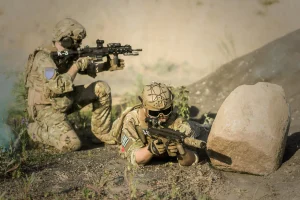To save some sweat of soldiers, the US research agency called DARPA is working on AI technology to assist in wound dressing, helicopter flying and even machine repairing.
The idea is to create a task guidance system that can see, hear, and understand what a soldier intends to do.
With these capabilities, soldiers who are wearing an AR headset, which are goggles that display virtual objects, get step-by-step instructions and alerts on making mistakes.
All assistance happens in real-time as the soldier performs their task.
Technology:

Artificial intelligence recognizes patterns. When you train an AI for tasks like wound dressing, you feed in it the data regarding ‘how a wound looks like’, ‘how worse is the wound’, and ‘which medicine should be applied and how’.
Once learnt the very features of a task, Computer Vision technology is used to capture what the soldier sees. It uses sensors such as camera lens and microphone to accurately create a digital version of the imagery.
At the back, the AI comes into action which uses this data to understand and recognize the scene. The intelligence algorithm generates instructions on what to do next.
The last step is performed by AR technology that creates and displays the virtual instructions on the soldier’s scene.
The Impact: With the powerful AI assistants, soldiers no longer need to memorize complex details during their time on the battlefield. The technology brings exceptional ease for the military personnel to quickly and correctly perform their tasks in the fatal scenario of the front line.
The Project: The US Defense agency DARPA focuses on research projects that bring advanced defense capabilities for soldiers in the battlefield.
In 2021, the agency initiated a research grant called Perceptually-enabled Task Guidance (PTG) program. DARPA awarded research grants to experts from around the US, each of them working to create innovative assistive technology for the military.
The team recently met in MIT where each technologist demonstrated the first version of their project. For now, DARPA tasked the teams to make their AI demonstrate how to follow a cooking recipe.
Well, why a cooking recipe?
“[Cooking is] visually quite complex,” said Draper, manager of the PTG program. “There’s specialized terminology. There are specialized devices, and there’s a lot of different ways it can be accomplished, so it’s a really good practice domain for all kinds of other highly skilled tasks.”
“Cooking is a good practice domain for all kinds of skilled tasks”
Future Outlook: Next, the first three tasks DARPA wants from its PTG team is to train their AI’s in: battlefield medicine, machine repair and pilot guide.
It’s not very clear when DARPA would see field soldiers use PTG tech, however the teams are already ahead of schedule– demonstrating their AIs assisting in medicine tasks.
Civilians might also be able to use AI assistants in their daily work routine in the future, since other public tech such as GPS and the Internet were also initially dedicated for military use.
“We believe that our system would not only be useful to DARPA and the military, but also to regular users and people who want to perform new or complex tasks,” said Ehsan Elhamifar, a professor at Northeastern University and one of the PTG grant recipients.




